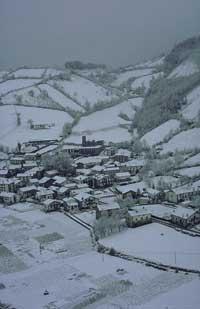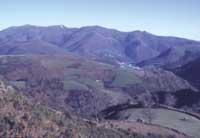Amateur news: February
1999/01/31 Elosegi Irurtia, Migel M.
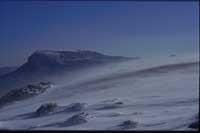
At the start of the morning I realized that winter has come to us. And I have brought the thermometers, the chin, the nose and the ears of my Basque very red and cold sore. The wind entered the bones and after mowing my feet at dawn, my fingers have not been tempered until noon. Anyway, returning home, taking the hot shower, sucking the soup from the boiling vegetable garden and sitting next to the low fire, I soon warmed up. Very sweet, I have started to think what do the animals that are outside to not end the cold, until I have fallen asleep in five minutes. Hard times
Winter is certainly the hardest season for most animals. When it snows eagerly, for example, those who move with gravity are heaps. To survive in this hard time many have to go from top to bottom, from the mountain to the valleys and to the holes protected from icy winds. But to realize it you don't need to go far. In towns and cities it is easy to look at it. Thus, in the snowfall they can appear on the balcony, in the gardens or in the park of the street in search of something that allows us to go inside. In many places people throw crumbs and/or pistes and, of course, they willingly disguise these gifts.
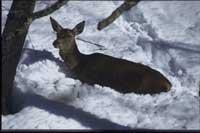
During the snowstorm, most mammals seek and expect, as far as possible, some kind of protection. Many pine forests, holm oaks, shrubs, ponds and young forests come in search of the most temperate corners. Fortunately, in the white-white area it is also common to find some green, and most herbivores can eat pine leaves, spikes of brambles, ivy, tree bark or aceb leaves. This last tree, holly, is of great importance to some species. In addition to being dressed in leaf, this tree gives in winter well-known red fruits and eat many birds and mammals. For example, the rooster is one of those who manages to survive in these times thanks to the fruits of the holly.
Snow has many attractions. As for the observation of animals, when it snows it is not difficult to find the legs of mammals that are usually hardly visible. Therefore, just be attentive to the snow to detect their movements and ultimately learn about their way of life. The fox, for example, went down tonight to the village and dared to walk among houses in the hope of something that would allow him to vomit. Further up we find wreckage. The poteka-poteka has gone to a lot of herbs and, opening the hole, has eaten a few rays of grass. The remains of wild boar are found in the upper hull. In these heights we entered the snow to the waist, so the wild boars were forced to enter or reach the ears. However, they stand behind each other and go online dragging the belly in the snow from one mountain to another. Once again, boars have taught us that they have a very special time.
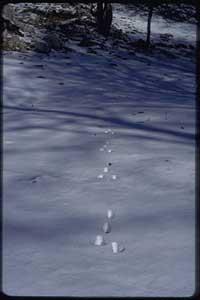
Surviving in this situation is not easy. Although for several days you can live thanks to body reserves without belly, the snowstorm will last the day... or if afterward the frosts arrive, many will overlook. In the Gorbeia, or in the forests of Quinto Real, deer and roe deer can often be seen from the vicinity of the road and sometimes you can find some dead specimen. "What a life! Humanized beasts!" Someone might think... Yes, it is. But this is the good example of natural selection. Some animals die, but many others advance. The latter are the strongest, the hardest, the fastest and the healthiest, and of course, this way ensures the improvement and survival of the species. We have already mentioned the harmful effect of snow on many animals. However, it can have beneficial effects. Snow plots that inhabit Ranero, Aizkorri, Aralar and the Pyrenees, for example, opening holes under snow almost without the danger of predators, can look for food. Often, and especially on windy days, the outside temperature is usually zero, but under the snow, so close to zero, that is, more temperate. Some plants also survive in winter thanks to the insulating capacity of snow.
It has already been mentioned that the snowfall can be targeted filter and eliminate the weakest specimens. However, do not think that those animals that die are lost in it. Sooner or later, this flesh will become a food of another species and the death of some, more than ever, will allow the survival of others. A stag finished in flour can become food of fox, grapefruit, bele, milano, etc. In the most serious fasts, some animals even eat with dead species. Larran, perfectly camouflaged
If we go to the highest mountains of Euskal Herria, we can find the lady of the snows. This lady panpox is the white partridge, a hard population that is only found in our territory in the highlands of Belagua. The elegant bird, as a Parisian model, presents a different dress for each season of the year and in winter it dresses in white and white. Of course, rather than being beautiful with these plumage, it is about getting the most appropriate camouflage for each time that protects them from their enemies; in addition, to make it more difficult for predators, it has the ability to hide them without leaving a trace in the snow. To do this, fly from top to bottom and dive into the snow.
But don't think that the only animal that dresses in white is the partridge. The armiño that inhabits the mountains of the Pyrenean area, or of Carranza, also occupies the white coat during the winter. This carnivore is a great hunter of mice and sattones. In fact, it has a long and thin body, similar to that of the vertex, which can be inserted into the holes of rodents to catch them.
In the highlands of Araba and West Bizkaia hunger has also tightened the stomachs and in the darkness of the night the braves have been heard in the highlands of Kuartango. United in the group, opening the claws so as not to sink in the snow, the wolves throw themselves to the hunt. At the end of the forest, a young roe deer has been raised and caught in a jam. Thank you! It was three days that they did not eat a citrine fox and that they were tempted to go down to the flock from the bottom. If those old shepherds were not completely...
Published in 7

Gai honi buruzko eduki gehiago
Elhuyarrek garatutako teknologia




